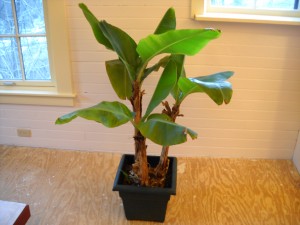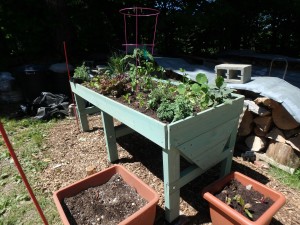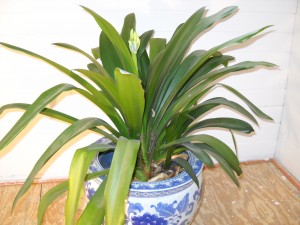It’s Not Too Late to Start an Herb Garden
Garden centers are mostly sold out of flowers and vegetables by now, but there seem to be plenty of herbs still for sale. Now that you have (hopefully) gotten your veggies and annual flowers planted, this is a good time to plant some herbs.
My vegetable garden –where I have always grown herbs – is somewhat remote from my house and down a set of stone steps. But this summer I have an herb garden between my car park and wood pile – just 10 steps or so from the house.
So how do I grow parsley, sage, rosemary and thyme (and others not included in Simon and Garfunkel’s song) in a spot that sounds so inhospitable? I am growing them in a wooden container called a VegTrug that I got from Gardeners Supply (www.gardeners.com). It’s big and deep: six feet long, 2 feet wide and up to 18 inches deep in the middle of the V-shaped container. It is on legs and stands 30 inches high. Very nice, no bending over.
Filling up the VegTrug with appropriate planting mix is important: you can’t just dig garden dirt and shovel it in. The soil would compact and the plants wouldn’t thrive. But it takes over 400 quarts of soil mix to fill this behemoth. To buy that much potting mix would be pricey.
Getting the mix right is important: you want your mix to stay fluffy, hold water and offer nutrients. But if you just used a standard commercial potting mix, your growing medium would need weekly infusions of liquid chemical fertilizer. Adding compost introduces organic matter and beneficial microorganisms that work with the roots of your plants to share nutrients from the compost and organic potting soil.
I buy good quality compost each year that a local contractor makes from cow barn scrapings that he turns and aerates and makes into lovely light-weight compost that is relatively weed free. I mixed that compost with peat moss, “Moo-Grow” (an organic potting soil), organic fertilizer, limestone, perlite and vermiculite.
Vermiculite is a fluffy material made from heat-expanded mica that holds water. It is used in most potting mixes, though you might not notice it. I also added perlite, another heat-expanded mineral. It looks like Styrofoam, but is great for containers: it has a neutral pH, holds water and air, does not deteriorate or compress. I used a total of 6 quarts of each in my VegTrug. Perlite and vermiculite go a long way.
To make my soil mix I used a 5-gallon pail to measure, adding roughly 2 parts of compost and 2 parts of Moo-Gro potting mix to one part of peat moss. I stirred up that mix in a huge garden cart. I added half a cup of limestone per bucket of peat moss to counteract the acidity.
Once the ingredients were mixed, I add Pro-Gro, an organic bagged fertilizer. I used a total of 2 quart containers of Pro-Gro in the 100-plus gallons of soil mix I made. I added one quart of Azomite, a source of diverse mineral micronutrients, in the total mix. Azomite is optional. You could add rock dust instead, if you can get some very fine rock powder from a tombstone maker or a rock quarry. Or you can leave it out altogether.
It is important to get the ingredients well moistened before adding them to the VegTrug. I did this by adding water from my hose to the mix, and stirring with a shovel. Dry peat moss can be very hard to moisten; I wet it, stirred it, let it sit, and repeated until it seemed evenly moist.
So what am I growing? In the middle, where the soil is deepest, I have a tomato plant, one I started from seed called ‘Summer Sunrise’. The seeds came from the Hudson Valley Seed Library (www.seeedlibrary.org and is suited for container growing.
What else? I have about a dozen lettuce plants, 3 flat-leafed parsley plants, 2 kinds of sage, a rosemary and a thyme plant. I dug up a chunk of chives from my garden, cut it back and planted it in the VegTrug. Marjoram and a nasturtium are doing well – the latter has edible flowers, and will flow out and over from the VegTrug.
I planted dill and arugula by seed – both are up and doing fine, though I also bought a small pot of dill at my local Food Coop – another good source for pots of herbs. Lastly I planted a 4-pack of small basil plants. Everything is thriving!
Watering is important for containers. This VegTrug has shallow soil near the edges, deeper soil towards the middle, so the edges dry out quicker. I find I need to give it 4 to 6 gallons in hot, sunny weather. It only gets sunshine from 9am to 3pm, but that seems adequate.
So whether you invest in a VegTrug from Gardeners Supply or just grow some herbs in pots on the porch, go plant some. I am so delighted with my herb garden I know I will plant it again every year. And the collection of herbs in this nice cedar container is pleasing to the eye as well as the taste buds!
Read Henry’s blogs at https://dailyuv.com/
Easy Houseplants to Brighten Your Winter
Before we launch into this week’s article…
Gardening Classes with Henry
Lebanon College: Gardening: A Practical Workshop. Garden writer Henry Homeyer will teach you the basics of organic vegetable and flower gardening. From garden design to seed-starting , planting, watering, weeding, mulching, and harvesting, this course will give each student practical knowledge of gardening. Tuesday nights from 6:30-8:30 for 5 weeks, April 3-May 2.Contact Lebanon College to reserve a spot for this5-part workshop www.lebanoncollege.edu or call 603-448-2445.
AVA Gallery, Lebanon. Henry will teach 3 classes at AVA Gallery this spring. You may sign up for one or all of these workshops:
Sculpting the Living Landscape: Starting Flowers from Seed
April 9; Monday, 6:30–8:30pm; One 2-hour class
Sculpting the Living Landscape: Perfect Perennials for the Upper Valley Garden
April 23; Monday, 6:30–8:30pm; One 2-hour class
Sculpting the Living Landscape: Organic Techniques for Enriching Soil and Managing Pests
May 7; Monday, 6:30–8:30pm; One 2-hour class
For more information go to www.avagallery.org or call 603-448-3117.
Easy Houseplants to Brighten Your Winter
Many a would-be gardener has been deterred from growing veggies or flowers outdoors because they’ve had a bad time with houseplants. “Garden? Not me! I’ve got a brown thumb.” If I’ve heard it once, I’ve heard it dozens of times. When I inquire, people tell me they’ve killed houseplants, even the so-called “bullet proof” ones.
More houseplants are killed by over-watering than by under-watering. Some inexperienced gardeners think they are being kind and attentive to their plants by watering often. But roots of most houseplants will rot if kept constantly wet. So my first rule of indoors plants is simple: only water a plant when the soil is dry to the touch. For most, that is no more than once a week. For some once every 3-4 weeks is adequate.
Some houseplants are grown for their blossoms and others for their lovely foliage. Foliage plants are generally the easiest: if it isn’t dead, it probably looks good.
Jade plant (Crassula ovate or C. argentea) is an easy plant that is almost trouble-free. It has thick, waxy succulent leaves that are round and shiny. The trunk is thick in mature plants, and is a smooth gray or brown. My friend Cindy Heath has one, and it languishes in her living room getting no care at all. I mean it gets little direct sunshine and if it gets a drink of water every couple of months, it’s lucky. Last summer I carried it outside on the porch for some sunshine, which prompted a growth spurt.
Jade plants are easy to propagate. Bernice Johnson of Cornish Flat, NH, showed me a jade plant that she started from a cutting 3 years ago that is now about 2 feet tall and 2 feet across. She said that to get a new plant she just snips off a short section of a branch with a leaf or two, and plants it, or sets it in water to root, then plants it. She plants her many houseplants in a mix of garden soil and compost she makes herself from leaves and garden waste. The soil drains well, which is important. She keeps the plant near a north window and waters it about once a month. I find a 50-50 mix of compost and potting soil is good for most houseplants.
Happy Griffiths of Lebanon, NH grows many houseplants, including both rosemary and bay. Those two not only produce handsome foliage, but also edible herbs for use in the kitchen. Both, she told me, like a cool environment with bright natural light. She keeps hers in an unheated sunroom that gets down below freezing on cold nights, but never very cold. Some forms of rosemary bloom annually, though other types do not.
If you grow rosemary indoors, you need to increase the water you give it starting in March, or even by mid- February. The sun is stronger, the days are longer, and the roots and leaves are beginning to grow. Even though it is a Mediterranean plant, if it gets totally dried out – as mine have in the past – the plant dies. Instead of once a week, water twice a week.
I grow clivia (Clivia spp.) as a foliage plant – it has long, shiny strap-shaped leaves and requires virtually no care. I’ve had mine for more than 10 years and have never divided it nor fertilized it. Even so, once a year it sends up a flower spike with a big cluster of orange blossoms that last for a couple of weeks. I water it very irregularly –once a month, if I think of it. It doesn’t need direct light, which is nice as I have it in a pot too big for the window sill. Its leaves stand about 30 inches tall.
Another nice foliage plant is aloe (Aloe vera)). It is a succulent that needs little watering, rarely has pests, and survives wherever you plunk it. A nice benefit is that if you cut a leaf and rub the juice on a burn or insect bite it will soothe your skin.
Bernice Johnson grows lots of old fashioned geraniums (Pelargonium spp.) that she keeps on sunny window sills. When I visited her recently she had one in full bloom in her warm kitchen that also has a wood stove. Wood stoves generally are hard on houseplants – they make rooms too hot and too dry for most. But her geraniums thrive – in part because she waters them regularly. In the spring she will cut back the long stems and put them outside, pots and all, for the summer.
I recommend that everyone have a few houseplants. I have too many (including a large banana plant, a hibiscus tree, a nice clump of papyrus and many more). Plants make the interior air more humid, and some take out pollutants. And best of all, they keep my hand in gardening activities all winter long.
Visit Henry’s Web site, www.Gardening-guy.com for more information and photos of houseplants. His e-mail is henry.homeyer@comcast.net
Web Extras: Other House Plants I Grow
 Another great foliage plant I grow is a banana “tree”. They don’t get woody, even in the tropics, but can get tall – even in the house. I got a small one 5 years ago and have been growing it in a large pot since then. In the summer it is outside, and in the winter I keep it in a west-facing window. Well, not in the window,but on the floor near the window. The banana has yet to produce fruit, but it has made 3 or 4 shoots that I intend to separate next summer and put in individual pots. My banana is now 4 feet tall, and has never had aphids or other pests.
Another great foliage plant I grow is a banana “tree”. They don’t get woody, even in the tropics, but can get tall – even in the house. I got a small one 5 years ago and have been growing it in a large pot since then. In the summer it is outside, and in the winter I keep it in a west-facing window. Well, not in the window,but on the floor near the window. The banana has yet to produce fruit, but it has made 3 or 4 shoots that I intend to separate next summer and put in individual pots. My banana is now 4 feet tall, and has never had aphids or other pests.
The exception to the rule, “Don’t overwater” is the papyrus. It needs to grow in a constantly wet location. I planted a small one a few years ago in a nice Chinese vase that has no hole. I water until the water is saturated and standing water is above the soil line. I grow mine in an east-facing window. The stems get to be 3-feet tall, with nice lacy fronds.
Pineapple plants, decorative ones, are also on the market this year. I got one at a florist shop and it is very nice. It has a miniature pineapple on a stem above the foliage, but it will never get big – or edible.




